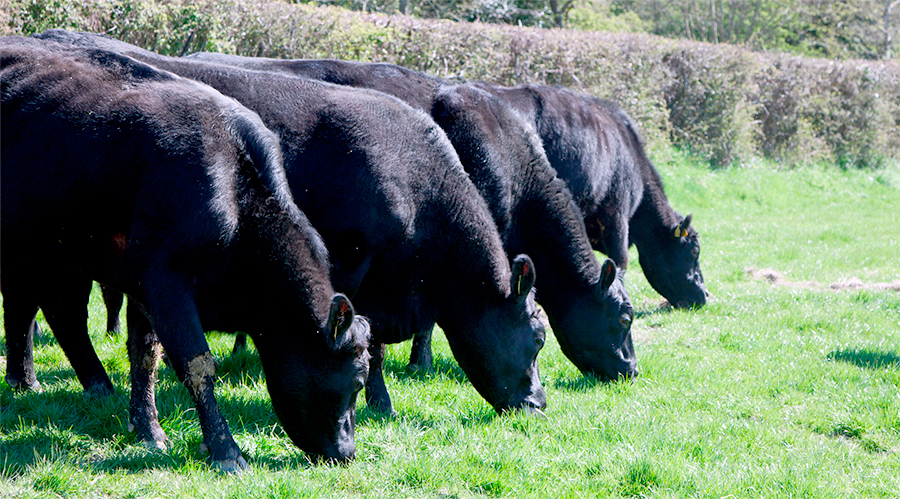
The incurable cattle disease Johne’s was one of the main discussion topics at the recent beef cattle finishing monitor farm meeting, hosted by the Paterson family of Hartbush Farm, Dumfries.
John and Amanda Paterson run approximately 250, mainly Simmental cross, cows at Hartbush, a 606 acre (245 ha) mixed farm, just north of Dumfries. Hartbush, the most southerly of the Scotland-wide network of Quality Meat Scotland (QMS) monitor farms, is the only monitor farm focussing primarily on beef cattle finishing.
“It’s common and financial sense to run a healthy herd,” Mr Paterson told the monitor farm community group. “We started blood testing for BVD (Bovine Viral Diarrhoea) and Johne’s in 2010, and have continued to do this annually.
“In 2010 four animals tested positive for Johne’s; in 2011 there were six, one of the worst Johne’s test results we’ve had. In December 2014, there was just one positive. We are currently at Risk Level 3 and when we test in December this year, we hope to improve to Level 2.”
The Patersons cull all Johne’s positive cattle. Johne’s, a slowly progressive, inevitably fatal infection of the intestines is a bacterial disease caused by Mycobacterium avium subspecies paratuberculosis, abbreviated to MAP.
It causes loss of body condition, performance and can lead to infertility. During the latter stages of infection, the animal often scours profusely, contaminating the pasture and/or housing, leading to an increased risk of infection to other animals in the herd.
Vet Colin Mason, based at SAC’s Disease Surveillance Centre in Dumfries also attended the meeting and gave the community group practical, farm-level, information and advice on Johne’s.
He told the group: “Some call Johne’s the ‘muck in mouth disease’. The most common means of spread is through faecal material, with young calves in the first month of life being most vulnerable. If they ingest muck carrying the MAP bacteria, for example - from their dam’s udder- they are likely to become infected. Control can be helped by ensuring cows’ teats are as clean as possible for calves to suckle from, through good calving pen hygiene and keeping pregnant cows well bedded.
“And while calves are the most vulnerable, it is possible for older stock to become infected, particularly if kept in a poor environment.
“Johne’s can also spread vertically – from dam to calf - so if a cow tests positive, the ideal is to cull any of her daughters in the herd. However, this may impact severely on herd numbers. An alternative in this situation is to consider culling the two most recent calves, if they have been retained, as they are the most at risk animals.”
There are three Johne’s tests for live animals – blood, faecal and Gamma Interferon, with the blood and faecal tests currently yielding the most accurate results.
“The blood test will pick up most positive animals, but perhaps not all and is more reliable in clinical cases,” explained Mr Mason.
“Results from faecal tests take up to eight weeks, but are more sensitive than blood and can identify MAP in younger animals at approximately 18 months of age, often the age of purchased breeding stock.”
He added: “The ideal is to buy from herds with a low Johne’s risk level and for the animals to be tested, with the results known before they arrive on your farm.”
John Paterson told the group that in 2011 and 2012, two purchased pedigree breeding animals, a bull and a heifer, had each tested (blood, followed by faecal) positive for Johne’s. He has since discounted these herds from the list of those from which he will buy replacement stock.
Mr Mason told the group: “Frustratingly it may be five to six years before an infected animal displays symptoms.” He outlined some Johne’s warning signs to look for including: a cow or bull that is eating well but is scouring and losing condition; unexplained loss of body condition; higher than usual number of barren cows; lower milk yield – calves not thriving as well as others in the group.
“If you have scouring, thin animals, test them for Johne’s!” advised Mr Mason. “If they’re negative then find out what is causing the problem.
“There is a post-mortem test, which is worth considering for barren cows, especially if daughters have been retained.”
The Patersons are herd blood testing annually in December for Johne’s, culling any positives after they have calved.
Mr Mason made the following recommendation to the group: “Once animals have tested positive, even if they look healthy, the quicker they are off your farm and not spreading the infection, the better.
“If in-calf, and kept until after calving, positives should be kept away from the clear stock, to reduce the risk of contaminating the calving environment and infecting other young calves in the group.
“When positives calve, try to ensure teats are as clean as possible before the calf sucks. Cull the dam promptly after weaning, and if she has a heifer calf, do not retain it for breeding.
“Importantly, be aware that the dung from the Johne’s positive cattle will carry the infection. This should be borne in mind if you’re taking cattle dung from other farms.
“And avoid turning cows and calves onto areas where cattle dung or slurry has recently been spread.”
Mr Mason also highlighted the fact that sheep and wildlife (e.g. rabbits and deer) can also carry and shed Johne’s. “So it’s strongly advised that sheep and cattle are not co-grazed, and wildlife is controlled.”
